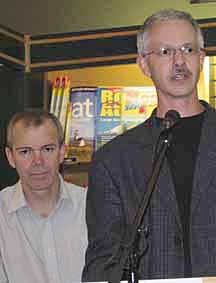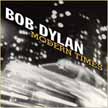Canadian Mennonite
Volume 10, No. 19
October 2, 2006

Book launch provides insights into ‘making the news’
Winnipeg
 |
Fittingly, the recent launch here of John Longhurst’s updated book, Making the News: An Essential Guide for Effective Media Relations, included local newsmakers. Bob Cox, editor of the Winnipeg Free Press, and Terry McLeod, host of CBC Information Radio, joined Longhurst in a “Religion and the media” presentation, offering helpful hints on how faith-based non-profit organizations can better “make the news.”
Their tips included:
•The use of Longhurst’s book as a resource.
“It’s very good for anyone because it’s realistic,” said Cox.
“I recommend it in my workshops because it’s simple and engaging,” added McLeod.
• Build long-term relationships with the media.
This is “key to getting the message out, said Cox, adding that this “takes not years, but decades.”
• Decide if your organization really wants to communicate with the media.
“Some try to keep us out,” said Cox.
• Put people—not the organization—at the beginning of the story.
“People are key,” said McLeod. “Wider stories are best seen through the eyes of ordinary individuals. In radio, I look for that.”
• Tailor stories for a specific news outlet.
“Radio is different from a daily paper,” said McLeod. “We seek to reflect diversity and the changing nature of our province.... Change is key.”
• Focus on what is new. That is the bottom line of a story.
• Find key communicators in your organization and utilize their skills.
Longhurst, who is currently director of communications and marketing at Canadian Mennonite University, wrapped up the presentation by reading the conclusion of his book. He emphasized the larger goal of non-profit organizations, which is to “share good news…the good things that happen in the world [which] often fly under the media radar, unless someone brings it to their attention.… Our job as communicators is to help ordinary people…tell their stories of human possibility.”
A wide-ranging discussion period followed. Listeners raised questions related to the truth of news-story aphorisms, such as “if it bleeds it leads,” and “timeliness is next to godliness,” as well as challenges about the “negative reporting” of Muslims, which some seemed to think is happening in the media now.
“Timing is everything,” Cox acknowledged. As for the negative reporting about Muslims, “it’s largely a lack of understanding,” he said. The lack of a Muslim point of view among staff and the wider community is a problem, he acknowledged, which makes it “a big job” to provide balanced coverage.
Dylan ponders the state of these ‘modern times’
 |
Bob Dylan. Modern Times. Columbia, 2006.
Bob Dylan has struck again with the release of a new album, Modern Times. Dylan again looks at the state of the times, dreams of romance, and gives a dark look at the future. What surprises is not the content, but that Dylan is still working with these issues at the age of 65.
Dylan indeed has been with us for years. It is hard to suggest that he has let us remain comfortable or that he has painted a beautiful picture, but he has helped us see more clearly the world we face. It is comforting when he sings, “I’ll be with you when the deal goes down” on the song of the same name. Dylan can’t ignore the rain and the possibility that the levee will break and that those in power will take as much as they can from the spoils.
“Workingman’s Blues No. 2’’ is a critique of the realities of the economy for the working class: “The buyin’ power of the proletariat’s gone down... Low wages are a reality / If we want to compete abroad.’’ He recognizes the global nature of the job market, but doesn’t let the rich who benefit the most from capitalism off the hook.
“Ain’t Talkin,” an almost nine-minute dirge, ends the album. It is an apocalyptic vision for today with little of the hope of “The Times They Are A Changin’” (from his 1964 album of the same name). On “Ain’t Talkin,’” he sings, “As I walked out last night in the mystic garden…there’s no one here, the gardener is gone.” But Dylan hasn’t given up: “I am a-tryin’ to love my neighbour and do good unto others / But oh, mother, things ain’t going well.” He even asks his mother for help: “They say prayer has the power to heal so pray for me, mother.”
This is just one of many references to spiritual matters on the disc. It is not clear if he has any hope left: “Heart burning still yearning, there’ll be no mercy for you once you’ve lost”; but he can’t get away from this long quest: “I practise a faith that’s been long a burning, there’s no altars on this long and lonesome road.”
This is a long journey—much like the song—and he is “walkin’ with a toothache in [his] heel.”
As the record drifts to a close we lose sight of him, and will have to wait for the next installment. I’ll keep listening to Dylan—since I find comfort in his keep-walking attitude as I face my own discomfort from living in this world. In spite of the darkness in the lyrics, listening to Dylan sing and play encourages the listener.